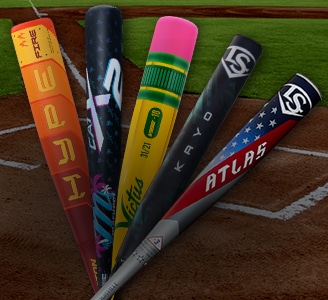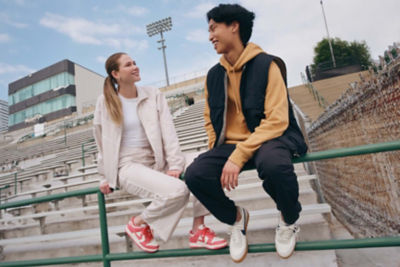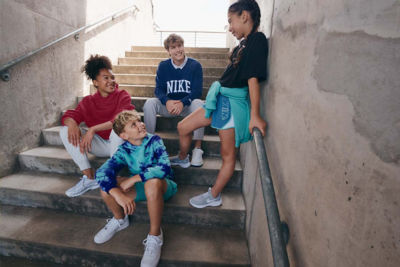The Pro Tips Guide to Kids' Shoe Sizes
When purchasing kicks for your kids, things can get confusing. Pro Tips can help with this kids’ shoe sizing guide.

When it comes to outfitting your little one’s feet, things can get a little complicated. The question of "how do kids' shoe sizes work" leaves many parents scratching their heads. Pro Tips is here to answer all of your most frequently asked questions when it comes to kids’ shoe sizes.
Kids' Shoe Size FAQ
Q. Is there a difference between toddler and youth shoe sizes?
A. Short answer – yes. There are three ranges for children’s shoe sizes by age: toddler, preschool and grade school.
Q. How do I identify what age group shoes are for?
A. There is always a number and letter associated with kids’ shoe sizes. DICK’S Sporting Goods identifies shoes for toddlers through young preschoolers with a 'K.’ 'K’ shoes go up to size 13. After a 13K starts a new range. This is where things start to get tricky. Shoes in this range run from 1-7. Therefore a '1’ is bigger than a '13K.’
Q. So then how do toddler shoe sizes work?
A. While toddler shoes often use the letter 'K' for identification, some brands may use a 'T’ or a 'C.’ Infant shoes start at a 0K. Shoes that fit a toddler will run from 4K-10K.
Q. What shoe sizes fit a preschooler?
A. Preschoolers can potentially fit into shoes in both ranges. Depending on the size of your little one, these shoes can range from 11K-3.
Q. Got it. So, what does grade school mean in shoes?
A. Grade school shoes run from 3.5-7. While this is often associated with elementary or primary school ages, women’s sizes begin to overlap with kids’ at around a 4.
Q. Okay. Then what happens after a size 7 in kids?
A. Men’s sizes are a continuation of kids’ sizes. The next size up after a kids’ size 7 is a men’s 7.5.
Q. If men’s shoes are a continuation of kids’, are boys and girls shoe sizes the same?
A. Yes. Although kids’ shoes run along the same sizing chart as men’s, youth shoes are unisex.
Q. Will my kids wear the same size shoe in every brand?
A. In-store youth shoe sizing mats can help you find a starting point. However, all brands have different size specs. It’s important to look at brand-specific size charts and have your child try the shoes on before wearing.
Q. How often do kids need new shoes?
A. When kids are young, their feet grow quickly. This is especially true for children under three. Expect to buy new shoes at least three or four times a year for toddlers. It isn’t uncommon for their feet to grow a ½ size every 2-3 months. Even if a shoe doesn’t show signs of wear and tear, it might still be time for a replacement. Watch out for scuffs to the toes, limping and blisters.
Grade school-aged children’s feet will grow a little slower, but their shoes might show more signs of wear. For this age group, needing a new pair 2-3 times a year is common. The best way to know for sure is to measure often and check in on their comfort.
Kids' Shoe Size Chart
Still have questions? Check out our kids' shoe sizing chart below with toddler shoe sizes, little kids' shoe sizes and big kids' shoe sizes. Keep in mind that conversions may vary by brand.
Kids' Shoes Shopping Tips
Kids grow quickly and it may be tempting to get ahead by purchasing shoes that they can “grow into.” However, shoes that are too large are more likely to cause blisters and other issues, so it’s best to buy shoes that fit at the time of purchase.
HOW TO MEASURE KIDS’ SHOES
When it comes to how to measure foot size for your child, it’s important that you check both the width and the length. There are a few tests you can do to ensure your child’s shoes fit correctly.
- Heel grip test: Pull on the heel of your child’s shoe to make sure there’s not any “heel slippage.”
- Width test: If you can see the outline of your child’s foot pressing against the shoe, it’s likely the wrong size. Feel for excess pressure on the little/outermost toe when the child is standing.
- Depth test: Pull your thumb across the top of the shoe. There should not be a large crease, as this would indicate too much depth.
- Length test: Feel for the longest toe. For infants, there should be a pinky width of space, while for older kids there should be an index finger’s worth.
HOW TO BUY KIDS’ SHOES
When choosing shoes for your little ones, here are a few things to keep in mind:
- Shop with them: It’s best for your child to be with you when you are purchasing new shoes for them. This way you can test the fit in the store and also give them input on the style and color.
- Buy for the larger foot: Not all foot sizes are created equal – even on the same person. If your child has feet that are slightly different in size, buy for the larger foot.
- Check the soles: Rubber soles are a good choice for children because of their shock absorption and cushioning. Textured soles also help kids keep their footing on unstable ground.
- Look at the closure style: Young kids may struggle with laces. Hook-and-loop and bungee closures are easy for kids who have yet to learn how to tie their shoes.
Kids grow quickly and so do their feet. Measure often and check on the wear and tear of their shoes to know when it’s time for new ones. Check out the latest assortment of kids' shoes at DICK'S.
Finding your size just got easier with the help of True Fit! Look for the True Fit icon on apparel and footwear product pages when shopping online at DICK’S Sporting Goods. Get personalized size and fit recommendations with just a few clicks. Learn more about True Fit.
Need more measuring tips? Click below to download a kids' shoe sizer chart.










